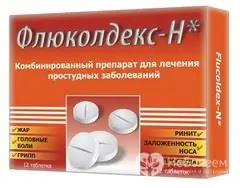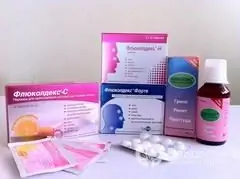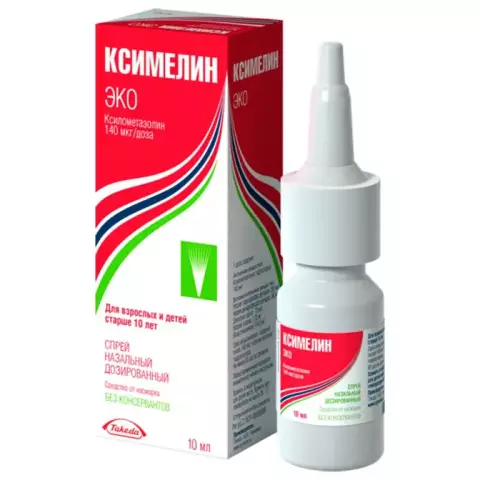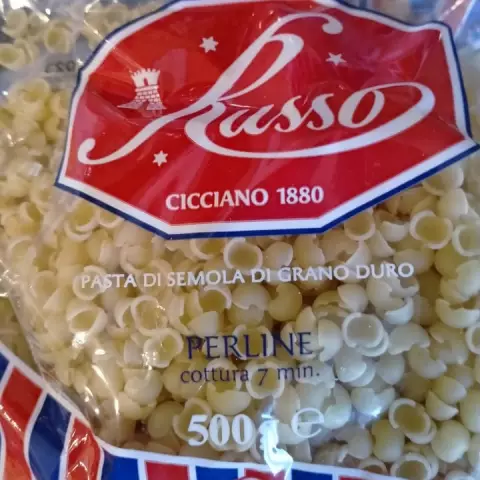- Author Rachel Wainwright [email protected].
- Public 2023-12-15 07:39.
- Last modified 2025-11-02 20:14.
Flucoldex
Instructions for use:
- 1. Release form and composition
- 2. Pharmacological action
- 3. Indications for use
- 4. Contraindications
- 5. Instructions for use
- 6. Drug interactions

Flucoldex is a multicomponent drug for the symptomatic treatment of colds and infectious diseases. Reviews of Flukoldeks confirm the high therapeutic effectiveness and speed of the medication.
Theraflu, Ekstratab, Fervex, Efferalgan with vitamin C, Kaffetin SK, Grippostad C are analogues of Flucoldex.
Release form and composition of Flucoldex
Flucoldex is produced in the form of tablets and also in the form of a suspension.
Each Flucoldex tablet contains paracetamol (500 mg), anhydrous caffeine (30 mg), phenylpropanolamine hydrochloride (25 mg), chlorpheniramine maleate (2 mg), as well as additional components: sodium benzoate, starch, gelatin, magnesium stearate, talc, polyvinylpyrroline sorbitol, sodium starch glycolate, sunset yellow dye.
5 ml of Flucoldex suspension contains 125 mg of paracetamol and 2 mg of chlorphenamine maleate.
pharmachologic effect
Flucoldex is a combined drug. Part of Flucoldexparacetamol has antipyretic and analgesic effects. Paracetamol acts on the centers of thermoregulation and pain, blocking COX only in the central nervous system. Chlorphenaminamaleate has antipruritic, antimuscarinic, antispasmodic, decongestant, antiexudative anti-allergic action (blocks H1-histamine receptors). In addition, chlorphenaminamaleate has a suppressive effect on the central nervous system, helps to reduce capillary permeability.
Caffeine has a pronounced stimulating effect on the cerebral cortex, vasomotor and respiratory centers, which manifests itself in an increase in strength and an increase in heart rate, blood pressure during hypotension. The action of this substance helps to increase mental and physical performance, reduce the feeling of fatigue and drowsiness. Caffeine weakens the action of components that depress the central nervous system.
Indications for the use of Flucoldex
Indications for the use of Flucoldex according to the instructions are as follows:
- febrile syndrome (infectious and colds);
- pain syndrome (migraine, arthralgia, neuralgia, myalgia, headache and toothache);
- rhinorrhea (allergic rhinitis, acute rhinitis);
- sinusitis.
Contraindications
- hypersensitivity to any component of Flucoldex;
- children under six years of age;
- deficiency of glucose-6-phosphate dehydrogenase;
- renal and / or hepatic impairment;
- lactation period;
- pregnancy;
- thyrotoxicosis;
- heart failure (chronic form);
- diabetes;
- blood diseases;
- arterial hypertension;
- analgesic nephropathy;
- hyperplasia of the prostate;
- pheochromocytoma.
Flucoldex should be used with caution in congenital hyperbilirubinemia (Gilbert, Rotor and Dubin-Johnson syndromes), alcoholism, angle-closure glaucoma, prostatic hyperplasia, in old age.
Instructions for use
According to the instructions, Flucoldex in the form of a suspension should be used in the following standard doses:
- children 3-5 years old - 5 ml twice a day;
- children aged 6-10 years - 5 ml three to four times a day;
- children 10-15 years old - 10 ml three times a day;
- adults and adolescents from 16 years old - 10 ml of suspension from four to six times a day.
The course of treatment is five days.

Flucoldex tablets are recommended for adults two to three times a day (one tablet each).
Judging by the reviews about Flukoldex, the drug is well tolerated in most cases. However, the following side effects are possible: impaired appetite, dizziness, dry mucous membranes, increased blood pressure, stimulation of the central nervous system, vomiting, gastrointestinal irritation, allergic reactions, epigastric pain, hemolytic disorders, urinary retention.
Some reviews about Flukoldeks indicate that with prolonged use, the medication has a hepatotoxic effect. In addition, long-term use of Flucoldex in large doses can lead to the development of glucosuria, interstitial nephritis, and papillary necrosis.
Drug interactions
- long-term combined use of Flucoldex and barbiturates reduces the effectiveness of paracetamol;
- paracetamol reduces the effect of uricosuric drugs and increases the effectiveness of indirect anticoagulants;
- long-term simultaneous use of paracetamol and other NSAIDs increases the risk of developing renal papillary necrosis and "analgesic" nephropathy;
- Diflunisal increases the concentration of paracetamol in blood plasma by 50% (the risk of developing hepatotoxicity);
- myelotoxic drugs increase the manifestations of Flucoldex hepatotoxicity;
- combined long-term use in the treatment of salicylates and paracetamol in high doses increases the risk of developing bladder cancer.
Information about the drug is generalized, provided for informational purposes only and does not replace the official instructions. Self-medication is hazardous to health!






